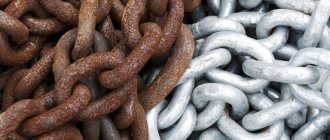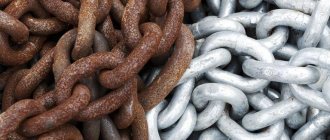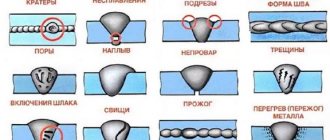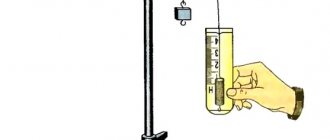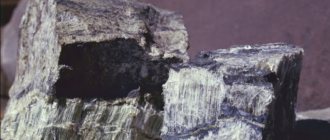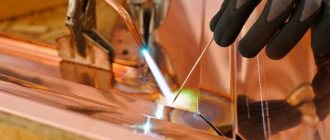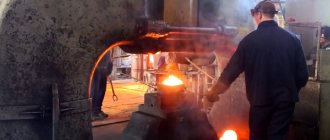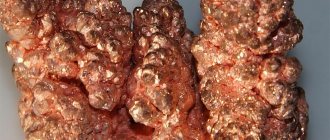Deformation is a change in the size and shape of a body under the influence of applied forces. Deformation is divided into elastic and plastic.
Elastic deformation. Elastic deformation is deformation, the influence of which on the shape, structure and properties of the body is completely eliminated after the cessation of external forces. Elastic deformation does not cause noticeable residual changes in the structure and properties of the metal; under the action of the applied load, only a slight relative and completely reversible displacement of the atoms occurs.
Plastic deformation. When shear stress increases above a certain value (elasticity limit or threshold), the deformation becomes irreversible. When the load is removed, only the elastic component of the deformation is eliminated. Part of the deformation, which is called plastic, remains.
Plastic deformation in crystals can occur by sliding and twinning. Sliding (displacement) of individual parts of the crystal relative to each other occurs under the influence of tangential stresses, when these stresses in the plane and in the sliding direction reach a certain critical value (τk).
The diagram of elastic and plastic deformations of a metal with a cubic structure subjected to tangential stresses is shown in Fig. 18. This diagram gives a visual representation of the displacement of atoms in adjacent planes when shifted by one interatomic distance.
Sliding in the crystal lattice occurs along planes and directions with the most dense packing of atoms, where the value of shear resistance (τk) is the smallest, and the value of τ itself is significant. This is explained by the fact that the distance between neighboring atomic planes is greatest, i.e., the connection between them is the smallest.
The more possible sliding planes and directions in a metal, the higher its ability to undergo plastic deformation. Metals with a cubic crystal lattice have high ductility, since sliding in them occurs in many directions. Metals with a hexagonal close-packed structure are less ductile and therefore more difficult than metals with a cubic structure to be rolled, stamped and other methods of deformation.
The sliding process should not, however, be represented as the simultaneous movement of one part of the crystal relative to another. Such a rigid or synchronous shear would require stresses hundreds or even thousands of times higher than those at which the deformation process actually occurs.
Rice. 18. Scheme of elastic and plastic deformation of metal under the influence of shear stress:
a – initial crystal; b – elastic deformation; c – increase in elastic and plastic deformation caused by sliding under loading greater than the elastic limit; d – stresses that caused the shear to appear (residual deformation remained after the shear); d – formation of a twin.
Rice.
Fig. 19. Movement of an edge dislocation leading to the formation of a single shear step on the crystal surface: a – diagram of dislocation movement; b – edge dislocation in the crystal structure; c – the dislocation has moved to the bottom; d – by two interatomic distances in the lattice under the influence of applied voltage; e – dislocation emergence to the surface and the appearance of shear.
Slip occurs as a result of the movement of dislocations in the crystal, as shown in Fig. 19. In order for a dislocation to move from the initial position 1 to the neighboring position 14, it is not necessary to shift the entire upper half of the crystal by one interatomic distance.
It is enough for the following movements of atoms to occur : atom 1 to the position of atom 2, atom 3 to 4, atom 5 to 6, atom 7 to 8, atom 9 to 10, atom 11 to 12, atom 13 to 14 , atom 15 - in 16 and atom 17 - in 18. Atoms are also displaced not only in the plane of the drawing, but also in all atomic layers parallel to this plane.
Minor movements of atoms in the dislocation region lead to the movement of dislocations one interatomic distance.
It should be borne in mind that the movement of dislocations formed during the crystallization process is limited. Large deformations are only possible due to the fact that the movement of these dislocations causes the appearance or reproduction of a large number of new dislocations in the process of plastic deformation.
Twinning. Plastic deformation of some metals having close-packed K12 and G12 lattices, in addition to sliding, can be carried out by twinning, which comes down to the reorientation of a part of the crystal into a position symmetrical with respect to the first part relative to a plane called the twinning plane. Twinning, like slip, is accompanied by the passage of dislocations through the crystal.
With large deformations, as a result of sliding processes, grains (crystallites) change their shape. Before deformation, the grain had a rounded shape; after deformation, as a result of displacements along sliding planes, the grains are stretched in the direction of the acting forces τ, forming a fibrous or layered structure. Simultaneously with the change in the shape of the grain, the blocks inside it become fragmented and the misorientation angle between them increases.
Deformation texture. At a high degree of deformation, a preferential crystallographic orientation of grains occurs. The regular orientation of crystallites relative to external deforming forces is called texture (deformation texture).
Hardening. With an increase in the degree of deformation, the properties characterizing the resistance to deformation (σв, σт, НВ, etc.) increase, and the ability to plastic deformation - plasticity (δ and φ) decreases. This phenomenon of increasing hardening is called work hardening. Strengthening of the metal during plastic deformation (hardening) is explained by an increase in the number of defects in the crystal structure (dislocations, vacancies, interstitial atoms).
All defects in the crystal structure impede the movement of dislocations, and therefore increase the resistance to deformation and reduce ductility. Of greatest importance is the increase in the density of dislocations, since the interaction that arises between them inhibits their further movement. As a result of deformation, density and corrosion resistance decrease and electrical resistance increases. Cold deformation of ferromagnetic metals such as iron increases coercivity and decreases magnetic permeability.
Properties of plastically deformed metals.
As a result of cold plastic deformation, the metal is strengthened and its physical properties change - electrical resistance, magnetic properties, density. Riveted metal stores 5-10% of the energy spent on deformation. The stored energy is spent on the formation of lattice defects (for example, the dislocation density increases to 109-1012 cm-2) and on elastic distortions of the lattice. The properties of the cold-worked metal change the more strongly, the greater the degree of deformation (Fig. 20).
During deformation, the strength characteristics (hardness; σв; σ0.2; σур) increase and the ductility and toughness (δ; φ; an) decrease. Metals are intensively hardened in the initial stage of deformation; after 40% deformation, the mechanical properties change slightly. As the degree of deformation increases, the yield strength increases faster than the tensile strength (tensile strength).
Both characteristics of heavily cold-hardened metals are compared, and the elongation becomes equal to zero. This state of hardened metal is extreme; when you try to continue deformation, the metal is destroyed.
By hardening, hardness and temporary resistance (tensile strength) can be increased by 1.5-3 times, and the yield strength by 3-7 times at the maximum possible deformations. Metals with an fcc lattice are strengthened more strongly than metals with a bcc lattice. Among alloys with an fcc lattice, those in which the stacking fault energy is minimal are more strongly strengthened (for example, austenitic steel; aluminum bronze with 7% Al; nickel; and aluminum is only slightly strengthened).
Work hardening is widely used to improve the mechanical properties of parts manufactured by cold working methods. In particular, hardening of the surface layer of parts increases fatigue resistance. A decrease in ductility during work hardening is used to improve the cutting machinability of tough and ductile materials (aluminum alloys, brasses, etc.).
What is impact resistance and how is it measured?
Let's imagine the situation. A car is driving along the road at fast speed. Throughout its journey, it constantly experiences vibrations and axial loads on a number of parts and the suspension. However, everything is fine, all nodes are working correctly. Then the driver loses control and falls into a hole. Spare parts fail because internal stresses and forces, firstly, increase, and secondly, they become multidirectional.
The strength in this situation turned out to be low, since it was deformed and failed. Since different alloys tolerate mechanical and chemical influences differently, it is necessary to use different metals for different purposes (automotive industry, machine tool industry, ordinary stamping parts, nails, etc.).
The influence of heating on the structure and properties of cold-deformed metals.
The nonequilibrium structure created by cold deformation in most metals is stable at room temperature. The transition of the metal to a more stable state occurs when heated. The processes occurring during heating are divided into two main stages: recovery and recrystallization; both stages are accompanied by the release of heat and a decrease in free energy. Recovery occurs at relatively low temperatures, recrystallization at higher temperatures.
Return refers to all changes in the fine structure and properties that are not accompanied by a change in the microstructure of the deformed metal, i.e., the size and shape of the crystals do not change during recovery.
Recrystallization is the nucleation and growth of new crystals with fewer structural defects; As a result of recrystallization, completely new, most often equiaxed, crystals are formed.
Return. The return stage, in turn, is divided into two possible stages: rest and polygonization. Rest when heating deformed metals always occurs, and polygonization develops only under certain conditions.
Rest of a cold-deformed metal is the recovery stage in which, due to the movement of atoms, the number of point defects, mainly vacancies, decreases; in a number of metals, such as aluminum and iron, rest also includes the creep of dislocations, which is accompanied by the interaction of dislocations of different signs and leads to a noticeable decrease in their density. The redistribution of dislocations is also accompanied by a decrease in residual stresses.
Rest causes a significant decrease in electrical resistivity and an increase in the density of the metal. If during rest the dislocation density decreases, then a decrease in the hardness and strength of the metal (aluminum, iron) is observed; if the dislocation density does not change during rest, then rest is not accompanied by a change in mechanical properties (copper, brass, nickel).
Polygonization is the process of separating deformed metal grains into polygons - areas with a low dislocation density. These areas are called blocks. The polygonization process occurs in the rest-recrystallization temperature range and ends with the creation of a block structure.
Polygonization leads to further removal of elastic distortions of the crystal lattice and a more complete restoration of the physical properties of the metal. In this case, its mechanical properties change slightly. The texture is preserved, although it becomes blocky.
Following the return, recrystallization occurs, which consists in the nucleation and growth of new undistorted equiaxed grains (Fig. 21).
During primary recrystallization, equiaxed grains nucleate and grow in a deformed medium until the texture created by the deformation completely disappears. The nuclei of grains are individual energetically favorable blocks (recrystallization centers). After the texture disappears, the metal acquires an equilibrium fine-grained structure.
The total length of the boundaries of small grains is large. The grain boundary zones are thin (several atomic layers) highly distorted regions, since crystal lattices of differently oriented abutting grains meet here, and point defects and dislocations flow here. Therefore, the boundary zones of grains are characterized by high values of energy (surface energy), which decreases due to the rounding of grains and their further growth through the frontal movement of the boundary zones of growing grains and the absorption of small ones.
Atoms from small grains diffuse across the boundary into growing grains, causing the former to gradually disappear and the latter to grow. As a result, the number of grains in the metal structure decreases and their sizes increase. The growth of some equiaxed grains due to the disappearance of others is collective recrystallization.
The temperature at which recrystallization begins depends on many factors, primarily on the degree of deformation of the material and the content of impurities in it. It is determined that
Trekr = αTmel,
where Trekr is the absolute minimum recrystallization temperature; α is a coefficient that takes into account the above factors; Tmelt is the absolute melting temperature of a given substance.
The minimum recrystallization temperature of iron and other metals of technical purity is determined by the formula of A. A. Bochvar:
Trekp = (0.3…0.4) Melt.
The thermal operation, which consists of heating a deformed (textured) material to a temperature above Trekr, holding it and subsequent slow cooling (in an oven), is called recrystallization annealing.
Rice. 21. The influence of heating on the mechanical properties and structure of metal strengthened by deformation.
In practice, the temperature of recrystallization annealing is chosen higher than the calculated one (usually by 200...300°C), since the higher the heating temperature, the faster the recrystallization occurs, which is characterized, in particular, by a decrease in the hardness of the metal. For iron and low-carbon steel, the recrystallization annealing temperature is assumed to be 650...700°C.
In order for recrystallization to occur in the metal when heated, it requires at least minimal preliminary cold treatment (the critical degree of deformation εcr for iron is 5...6%, for low-carbon steel - 7...15, for copper - about 5, for aluminum - 2... 3%).
During recrystallization after deformation of a material with εcr, the grain grows in it especially strongly and can increase many times compared to the original. By choosing the degree of deformation and the temperature of recrystallization annealing, it is possible to obtain grains of the desired size in the metal. Recrystallization annealing is widely used to control the shape and size of grains, texture and properties of metals and alloys.
Creation of texture and hardening is possible only in the case of cold deformation of the metal. Pressure treatment is called cold if it is performed at temperatures below the recrystallization temperature, hot - at temperatures above the recrystallization temperature.
During hot pressure treatment, recrystallization occurs simultaneously with plastic deformation of the metal, which continues after deformation until the temperature of the metal drops below Trekr. At the same time, texture does not appear in metals and they are not hardened. This treatment is widely used in the production of hot-rolled semi-finished steel products of various profiles.
Self-test questions.
1. What happens in a metal during elastic deformation?
2. How does plastic deformation occur?
3. What is warp texture?
4. Explain the strengthening of metal during plastic deformation.
5. Describe the properties of plastically deformed metals.
6. How does heating affect the structure and properties of cold-worked metals?
7. Explain the essence of the recrystallization process.
8. What is the technology of recrystallization annealing?
9. What is the difference between hot and cold metal forming?
Deformation is a change in the size and shape of a body under the influence of applied forces. Deformation is divided into elastic and plastic.
Elastic deformation. Elastic deformation is deformation, the influence of which on the shape, structure and properties of the body is completely eliminated after the cessation of external forces. Elastic deformation does not cause noticeable residual changes in the structure and properties of the metal; under the action of the applied load, only a slight relative and completely reversible displacement of the atoms occurs.
Plastic deformation. When shear stress increases above a certain value (elasticity limit or threshold), the deformation becomes irreversible. When the load is removed, only the elastic component of the deformation is eliminated. Part of the deformation, which is called plastic, remains.
Plastic deformation in crystals can occur by sliding and twinning. Sliding (displacement) of individual parts of the crystal relative to each other occurs under the influence of tangential stresses, when these stresses in the plane and in the sliding direction reach a certain critical value (τk).
The diagram of elastic and plastic deformations of a metal with a cubic structure subjected to tangential stresses is shown in Fig. 18. This diagram gives a visual representation of the displacement of atoms in adjacent planes when shifted by one interatomic distance.
Sliding in the crystal lattice occurs along planes and directions with the most dense packing of atoms, where the value of shear resistance (τk) is the smallest, and the value of τ itself is significant. This is explained by the fact that the distance between neighboring atomic planes is greatest, i.e., the connection between them is the smallest.
The more possible sliding planes and directions in a metal, the higher its ability to undergo plastic deformation. Metals with a cubic crystal lattice have high ductility, since sliding in them occurs in many directions. Metals with a hexagonal close-packed structure are less ductile and therefore more difficult than metals with a cubic structure to be rolled, stamped and other methods of deformation.
The sliding process should not, however, be represented as the simultaneous movement of one part of the crystal relative to another. Such a rigid or synchronous shear would require stresses hundreds or even thousands of times higher than those at which the deformation process actually occurs.
Rice. 18. Scheme of elastic and plastic deformation of metal under the influence of shear stress:
a – initial crystal; b – elastic deformation; c – increase in elastic and plastic deformation caused by sliding under loading greater than the elastic limit; d – stresses that caused the shear to appear (residual deformation remained after the shear); d – formation of a twin.
Rice.
Fig. 19. Movement of an edge dislocation leading to the formation of a single shear step on the crystal surface: a – diagram of dislocation movement; b – edge dislocation in the crystal structure; c – the dislocation has moved to the bottom; d – by two interatomic distances in the lattice under the influence of applied voltage; e – dislocation emergence to the surface and the appearance of shear.
Slip occurs as a result of the movement of dislocations in the crystal, as shown in Fig. 19. In order for a dislocation to move from the initial position 1 to the neighboring position 14, it is not necessary to shift the entire upper half of the crystal by one interatomic distance.
It is enough for the following movements of atoms to occur : atom 1 to the position of atom 2, atom 3 to 4, atom 5 to 6, atom 7 to 8, atom 9 to 10, atom 11 to 12, atom 13 to 14 , atom 15 - in 16 and atom 17 - in 18. Atoms are also displaced not only in the plane of the drawing, but also in all atomic layers parallel to this plane.
Minor movements of atoms in the dislocation region lead to the movement of dislocations one interatomic distance.
It should be borne in mind that the movement of dislocations formed during the crystallization process is limited. Large deformations are only possible due to the fact that the movement of these dislocations causes the appearance or reproduction of a large number of new dislocations in the process of plastic deformation.
Twinning. Plastic deformation of some metals having close-packed K12 and G12 lattices, in addition to sliding, can be carried out by twinning, which comes down to the reorientation of a part of the crystal into a position symmetrical with respect to the first part relative to a plane called the twinning plane. Twinning, like slip, is accompanied by the passage of dislocations through the crystal.
With large deformations, as a result of sliding processes, grains (crystallites) change their shape. Before deformation, the grain had a rounded shape; after deformation, as a result of displacements along sliding planes, the grains are stretched in the direction of the acting forces τ, forming a fibrous or layered structure. Simultaneously with the change in the shape of the grain, the blocks inside it become fragmented and the misorientation angle between them increases.
Deformation texture. At a high degree of deformation, a preferential crystallographic orientation of grains occurs. The regular orientation of crystallites relative to external deforming forces is called texture (deformation texture).
Hardening. With an increase in the degree of deformation, the properties characterizing the resistance to deformation (σв, σт, НВ, etc.) increase, and the ability to plastic deformation - plasticity (δ and φ) decreases. This phenomenon of increasing hardening is called work hardening. Strengthening of the metal during plastic deformation (hardening) is explained by an increase in the number of defects in the crystal structure (dislocations, vacancies, interstitial atoms).
All defects in the crystal structure impede the movement of dislocations, and therefore increase the resistance to deformation and reduce ductility. Of greatest importance is the increase in the density of dislocations, since the interaction that arises between them inhibits their further movement. As a result of deformation, density and corrosion resistance decrease and electrical resistance increases. Cold deformation of ferromagnetic metals such as iron increases coercivity and decreases magnetic permeability.
Elastic deformation
As already indicated, this type of deformation is a change in the shape of the material over time, which is spontaneously removed after the force or external load is removed. The shape of a material changes when a force is applied within the elastic limit of the metal, otherwise known as Young's modulus. This physical property ensures that elastic materials return to their original dimensions after the applied load is removed. Here the deformation is reversible and not permanent. Elastic deformation of metals is usually observed with small changes in shape; their elastic behavior is usually linear.
Elastic deformation involves temporary stretching or bending of bonds between atoms of a crystal lattice. For example, when a steel sheet is bent, all the dislocations and bonds present in the metal are bent (or stretched) only by a few percent, but no relative movement of atoms is observed. Such deformation can be caused by the application of external shear forces, which cause corresponding tensile/compressive stresses.
The presence of elastic deformation of the material allows all bonds to recover after stress. But over time, these properties deteriorate, and in some conditions the metal can become brittle and lose its ductility. An example is the changes that occur in tin. With sharp temperature fluctuations, this metal becomes less plastic (allotropic transformations of β-tin into α-tin and vice versa, which in the Middle Ages were called the tin plague), are known. Often the changes are caused by exposure to certain chemicals that reduce the elastic properties of metals.
The elasticity (springiness) of steel increases with increasing percentage of carbon in it. It is no coincidence that special grades of steel are used for the production of automobile springs, the amount of carbon in which should not be less than 0.62...0.70% (GOST 14959-2016). An increased percentage of manganese and silicon also gives elasticity to such steels.
Properties of plastically deformed metals.
As a result of cold plastic deformation, the metal is strengthened and its physical properties change - electrical resistance, magnetic properties, density. Riveted metal stores 5-10% of the energy spent on deformation. The stored energy is spent on the formation of lattice defects (for example, the dislocation density increases to 109-1012 cm-2) and on elastic distortions of the lattice. The properties of the cold-worked metal change the more strongly, the greater the degree of deformation (Fig. 20).
During deformation, the strength characteristics (hardness; σв; σ0.2; σур) increase and the ductility and toughness (δ; φ; an) decrease. Metals are intensively hardened in the initial stage of deformation; after 40% deformation, the mechanical properties change slightly. As the degree of deformation increases, the yield strength increases faster than the tensile strength (tensile strength).
Both characteristics of heavily cold-hardened metals are compared, and the elongation becomes equal to zero. This state of hardened metal is extreme; when you try to continue deformation, the metal is destroyed.
By hardening, hardness and temporary resistance (tensile strength) can be increased by 1.5-3 times, and the yield strength by 3-7 times at the maximum possible deformations. Metals with an fcc lattice are strengthened more strongly than metals with a bcc lattice. Among alloys with an fcc lattice, those in which the stacking fault energy is minimal are more strongly strengthened (for example, austenitic steel; aluminum bronze with 7% Al; nickel; and aluminum is only slightly strengthened).
Work hardening is widely used to improve the mechanical properties of parts manufactured by cold working methods. In particular, hardening of the surface layer of parts increases fatigue resistance. A decrease in ductility during work hardening is used to improve the cutting machinability of tough and ductile materials (aluminum alloys, brasses, etc.).
Testing materials for impact strength: what is this procedure
Not all items can be tested. Since there is a kilogram standard that is ideally verified to the thousandth, only identical experimental specimens created in accordance with GOST are supplied to the laboratory. They can be of three types:
- Sharpie bars. This is rolled metal with a square cross-section with a side of 10 mm. It should be exactly 55 mm in length. There is no hollow hole inside, but there is a cut in the shape of the letter U. It is shown in the drawing below:
- Bar Menage. The previous parameters are the same, only the cut is different, which is made in the shape of the letter V. Such a sharp end of the cut leads to the fact that deformations or destruction will appear sooner than the previous one. Therefore, tests are necessary to determine the performance characteristics of systems subject to constant high loads, such as machine or vehicle components.
- The T-shaped cut is used in cases where even greater complexity and accuracy are needed, so the cut is made in the shape of the letter T.
There are several types of procedures. Its choice depends on the purpose for which the impact strength of the material is determined. From this the testing will be selected:
- method of fastening on the stand;
- using a weight or hammer as a tool;
- type of cut.
Pendulum pile driver
This is one of the most regular experiments, so we will describe it from the preparatory stage to the evaluation. The first and important rule is that all experimental bars must be completely identical in size, and they should also be manufactured simultaneously, under the same conditions - both from the point of view of the chemical composition of the alloy and from the metalworking side. Performance can be assessed by one of the following characteristics:
- fracture, cracks - this reaction is characteristic of either brittle steels, for example, cast iron (it is very strong, but has internal stresses);
- dents, scratches - they can be seen on a plastic material that is easily subject to deformation during dynamic or static influences.
Sampling
The entire technology for manufacturing blanks for experiments is prescribed in the corresponding regulatory document - GOST 7565. You should fully follow the standards therein, but sometimes a special technical order is received, for example, when special operating conditions for the part are predetermined. Then you can carry out the procedure according to the requirements, however, it is important that the temperature regime remains within the limits of the invariability of the crystal lattice.
Other tests
A hammer can be used instead of a pendulum. In addition to the strength of the steel workpiece, it is necessary to check for stretching and torsion, and for fracture. All this gives a complete comprehensive picture of a particular material for construction.
Table with indicators
There is no need to carry out experiments every time, since most of them have already been done. It is enough just to use the proposed GOSTs. Here are the figures for the various most common brands:
| Steel | Rolled thickness | Impact strength, J/cm2, not less | ||||
| KCU | KCV | |||||
| St3ps | 3,0 — 5,0 | — | 49 | — | 9,8 | |
| St3sp | 5,1 — 10,0 | 108 | 34 | — | ||
| St3Gps | 10,1 — 26,0 | 98 | 29 | — | ||
| St3Gsp | 26,1 — 40,0 | 88 | — | — | ||
| For St3ks - not standardized | ||||||
Processing the results obtained
After testing, either failure or deformation will be obtained. In the first case, you need to record this and then continue testing, but using little effort. And in the second, the results should be subjected to mathematical calculations using the above formula.
In the article we explained how impact strength is designated and how to find it out. To complete the topic, watch the video:
On the site you can learn about other properties of metals, as well as find a wide range of equipment for band sawing. Go to our catalog to find out more. To clarify the information you are interested in, please contact our managers by phone;; 8 (800) 707-53-38. They will answer all your questions.

